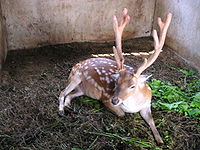- Formosan Sika Deer
-
Formosan Sika Deer Conservation status Scientific classification Kingdom: Animalia Phylum: Chordata Class: Mammalia Order: Artiodactyla Family: Cervidae Subfamily: Cervinae Genus: Cervus Species: C. nippon Subspecies: C. n. taioanus Trinomial name Cervus nippon taioanus The Formosa sika deer, (Chinese: 台灣梅花鹿; pinyin: Táiwān méihuālù; Pe̍h-ōe-jī: Tâi-oân hoe-lo̍k), is a subspecies of sika deer endemic to the island of Taiwan. Formosan sika, like most of the terrestrial fauna and flora of Taiwan, arrived on the island during Pleistocene glacial periods when lower sea levels connected Taiwan to the Asian mainland.
Contents
Appearance and Behavior
Sika stand 90-120 cm at the shoulder. Males are larger and bear deciduous antlers. The summer coat is light brownish, with obvious white spots, while in winter their coat is darker and the spots fade.
Range and Habitat
The natural distribution of sika on Taiwan was in the woodlands from sea level up to about 300 m elevation. Sika, like many deer, prefer areas of mixed forest, scrub, and open land. Under natural conditions the low-lying alluvial plain that stretches from present-day Taipei along the west coast almost to the southern tip of the island were prime deer habitat and natural populations would have been quite dense.
Status
Sika populations in Taiwan have been heavily influenced by human activity for the past four hundred years. Until the early 17th century the human population of Taiwan was low and comprised mostly Austronesian peoples who had been living on the island for 1000’s or years. During the 17th century immigration from the Chinese mainland increased dramatically in response to political instability in China and economic opportunities on Taiwan, which from 1624 until 1684 was controlled by the Dutch East India Company. The company, operating from the port of Taiwanfu (now Tainan) in southwestern Taiwan, established a trading post whose main business was the export of sika skins to Europe. During the six decades of Dutch activity two to four million sika skins were exported to Europe.[1][2] Exporting was reduced when the Dutch were forced out of Taiwan in 1684, but continued throughout the Qing period with a switch to Japan as the major export market.[3]
The intensive hunting of sika during the Dutch era must have severely decreased the population of sika. Sika populations continued to decline over the next few centuries as the human population expanded—the natural habitat of sika in the lowland plains was steadily converted to farmland, and later urbanized, as the human population increased. Hunting also continued. As a result, wild sika populations decreased steadily, and in 1969 the last known wild sika was killed.[4]
However, deer are easily kept in captivity and there were a number of captive populations of C. n. taiaoanus. In 1984 Taiwan’s Council of Agriculture funded the Sika Deer Reintroduction Project, based at Kenting National Park on the southern tip of the island. Twenty two deer were transferred from the Taipei zoo to serve as a founder population. Over the next 10 years the deer were maintained in enclosures until their eventual release into the National Park in 1994. Altogether over 200 deer have been released and the current population, now spread beyond the park borders, is estimated to exceed 1000 individuals.[5] Discussions regarding other possible reintroduction sites, including Yangmingshan National Park near Taipei, are ongoing.
External links
References
- ^ 江樹生。 1985。梅花鹿與台灣早期歷史關係之研究, 第3-62頁。台灣梅花鹿復育之研究七十四年度報告。內政部營建署墾丁國家公園管理處
- ^ Davidson, James W. 1903 The Island of Formosa, Past and Present. London: Macmillan & Co.
- ^ The Plight of the Formosan Sika
- ^ McCullough, D. R. 1974. Status of Larger Mammals in Taiwan. Taipei: Tourism Bureau
- ^ http://e-info.org.tw/node/57024
Categories:- IUCN Red List extinct in the wild species
- Cervus
- Mammals of Taiwan
- Even-toed ungulate stubs
- Taiwan stubs
Wikimedia Foundation. 2010.


